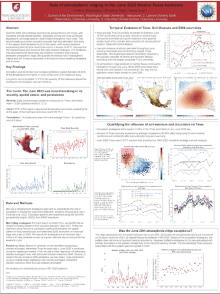Contribution of persistent atmospheric ridging to the June 2023 record-breaking heatwave in Mexico and Texas
Deepti
Singh
Washington State University Vancouver
Poster
In June 2023, a severe and persistent heatwave across Mexico and Texas broke multiple maximum temperature (Tmax) records and resulted in >130 fatalities. Using ERA5 atmospheric reanalysis, we characterize the intensity, spatial extent, and duration of this heatwave and compare it to past heatwaves over the combined Mexico-Texas region (April-September, 1940-2023). Our results show that this heatwave was the most widespread and severe heatwave over the region in this record. At its peak on June 20th, daily standardized Tmax anomalies exceeded 2σ over ~57% of domain. In addition, it was the most persistent heatwave by a substantial margin: 11 consecutive days with >2σ anomalies across at least 20% of the domain compared to the previous record of 3 days at these thresholds. This record-breaking heatwave was associated with a combination of atmospheric ridging that persisted for 15 consecutive days, long-term warming and record-low soil moisture conditions. We apply a constructed circulation analogues approach using historical, detrended 500-hPa geopotential height anomalies to quantify the relative contribution from atmospheric ridging and thermodynamic factors to the severity of the heatwave. We find that atmospheric ridging on June 20th explains ~43% of the observed regional-averaged Tmax anomaly (+3.52 σ) and its relative contribution increases to >50% in late-June. Similar ridging in the 20th century climate would result in temperature anomalies that were 1/3rd the magnitude of the observed 2023 anomalies. Although ridging was strong in June 2023, it was weaker than previous events on record. Our results suggests that relatively weaker ridges can contribute to record-breaking heatwaves in a warming climate.

Poster file
Singh_Deepti_blocking_poster (1).pdf
(11.65 MB)
Meeting homepage
